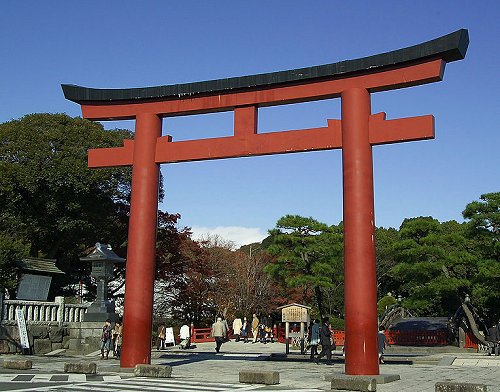 Kamakura (Japanese: 鎌倉市) is a city in Kanagawa Prefecture, Japan. It is located about 50 kilometers (31 miles) to the southwest of Tokyo. Kamakura is a popular tourist destination for people living in Tokyo as well as for tourists wishing to do a day-trip from there. It has many ancient temples and a beach. The local delicacy is senbei, a crispy grilled rice cake sold in the local shops.
Kamakura (Japanese: 鎌倉市) is a city in Kanagawa Prefecture, Japan. It is located about 50 kilometers (31 miles) to the southwest of Tokyo. Kamakura is a popular tourist destination for people living in Tokyo as well as for tourists wishing to do a day-trip from there. It has many ancient temples and a beach. The local delicacy is senbei, a crispy grilled rice cake sold in the local shops.The earliest evidence of human habitation in the Kamakura area dates back over 10,000 years ago. The earliest mention of Kamakura appeared in the 8th century.
The period of Japanese history under the Kamakura shogunate was known as the Kamakura period, which ends in 1333, but whose beginning is still a matter of debate among historians. Most historians do agree that between 1192 and 1333, Kamakura was stronger politically, culturally and economically, than the technical capital, Kyoto.
During the 19th century, the Meiji Restoration yielded a negative byproduct called haibutsu kishaku, or anti-Buddhism purge, when it became official policy to separate Shintoism from Buddhism. Many cultural treasures were lost during that time, and the blow was severe for Kamakura, which has many temples venerating both religions having to give away half their properties. Shinto shrines with attached Buddhist buildings had to destroy them, and some Buddhism temples were simply forced to close.
In 1914 the eruption of the volcano Sakurajima blanketed Kamakura in volcanic ash. By then the city was already in decline. Then came the 1923 Great Kanto Earthquake to finish what was left. The epicenter was just a short distance from Kamakura.
Due to all the devastation, many of the temples that we see today in Kamakura are only replicas of the original. It is also for that reason that Kamakura only has one National Treasure in the building category, which is the Shariden at Engaku-ji Temple.
 Kamakura, Japan
Kamakura, JapanSource: http://commons.wikimedia.org/wiki/File:Kamakura_Daibutsu_Dec08-1.jpg
Author: Eckhard Pecher

Author: Eckhard Pecher

Planning your trip to Kamakura
The fastest way to reach Kamakura is to take the train. It is just one hour away on the JR Yokosuka Line from Tokyo Station, and the fare is ¥890. A cheaper option is to take the Odakyu Line from Shinjuku to Fujisawa, then change train to the Enoden street-car that goes to Kamakura. It's a longer journey of 90 minutes, but you are rewarded by the gorgeous views of the Shonan coast and Enoshima Island.Planning your travel within Kamakura
Kamakura is a sprawling place, so it is not practical to attempt it on foot. There are two options to consider: one is to take the Enoden street-car. If you buy the Enoshima-Kamakura Free Pass, you get the round trip from Shinkuju as well as unlimited use of the Enoden street car for a day.Alternatively, you can rent a bicycle and explore at your own pace.
 Third Torii of the Tsurugaoka Hachiman Shrine, Kamakura
Third Torii of the Tsurugaoka Hachiman Shrine, KamakuraSource: http://commons.wikimedia.org/wiki/File:TsurugaokaHachiman-M8808.jpg
Author: Fg2

Author: Fg2

Places of Interest in Kamakura
- Great Buddha
The most famous landmark of Kamakura. - Hase-dera Temple
Home to the 11-faced Kannon, or goddess of mercy. - Hachiman-gu Shrine
Shrine dedicated to the god of war. - Kamakura National Treasure House Museum
Museum housing temple treasures. - Myohon-ji Temple
The largest Nichiren temple in Kamakura, built on a hill slope. - Hokoku-ji Temple
A Rinzai Zen temple founded in the 14th century. - Zuisen-ji Temple
Temple in a secluded garden setting created in 1327 by a monk. - Sugimoto-dera Temple
Kamakura's oldest temple, founded in AD 734. - Engaku-ji Temple
The largest of the Five Great Zen Temples of Kamakura. - Tokei-ji Temple
Quiet, small temple which was founded as a convent in 1285. - Meigetsu-Temple
Small Zen temple also known as the "Hydrangea Temple" for its plentiful hydrangeas that bloom in June. - Kencho-ji Temple
The foremost of the Five Great Zen Temples of Kamakura, and the oldest Zen training monastery in Japan. - Zeni-Arai Benten Shrine
Popular shrine dedicated to the goddess of music, literature and the arts.
 Latest updates on Penang Travel Tips
Latest updates on Penang Travel Tips
 Map of Roads in Penang
Map of Roads in Penang
Looking for information on Penang? Use this Map of Roads in Penang to zoom in on information about Penang, brought to you road by road.About this website

Dear visitor, thank you so much for reading this page. My name is Timothy Tye and my hobby is to find out about places, write about them and share the information with you on this website. I have been writing this site since 5 January 2003. Originally (from 2003 until 2009, the site was called AsiaExplorers. I changed the name to Penang Travel Tips in 2009, even though I describe more than just Penang but everywhere I go (I often need to tell people that "Penang Travel Tips" is not just information about Penang, but information written in Penang), especially places in Malaysia and Singapore, and in all the years since 2003, I have described over 20,000 places.
While I try my best to provide you information as accurate as I can get it to be, I do apologize for any errors and for outdated information which I am unaware. Nevertheless, I hope that what I have described here will be useful to you.
To get to know me better, do follow me on Facebook!
Copyright © 2003-2025 Timothy Tye. All Rights Reserved.

 Go Back
Go Back